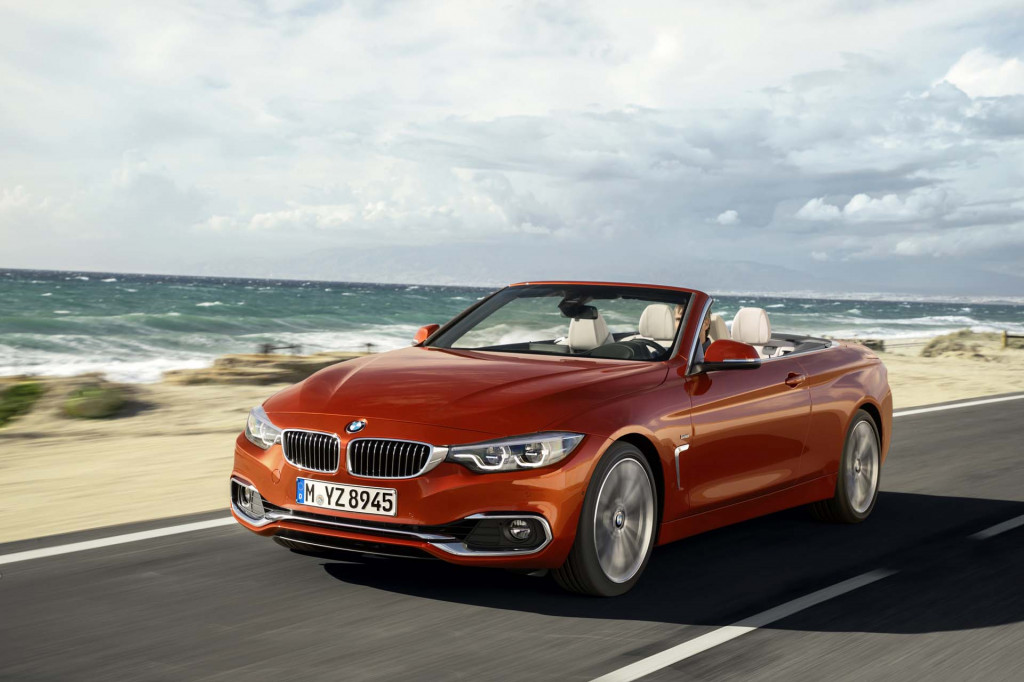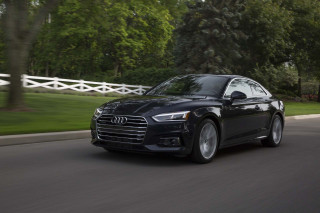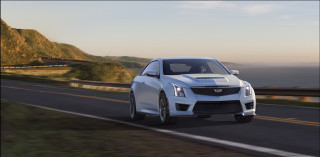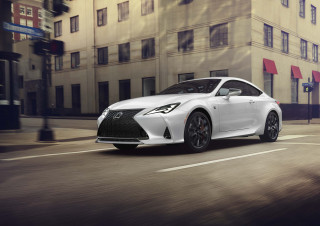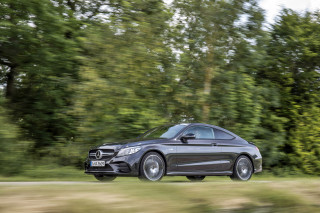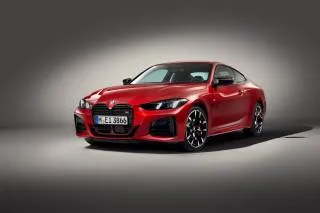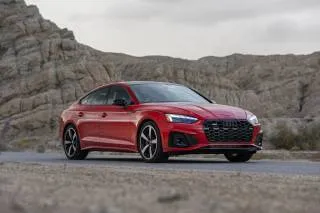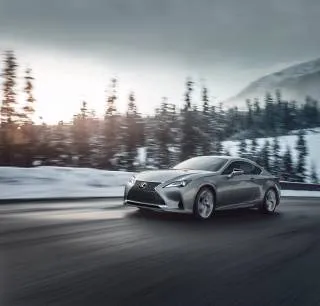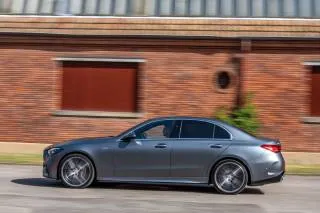Likes
- Impressive powertrains, all of them
- Good looks from all body styles
- Standard automatic emergency braking
- Bigger infotainment screen this year
- Gran Coupe is especially attractive
Dislikes
- More for Apple CarPlay after first year
- Small-ish rear seat
- Interior can be a little dull
- Leather isn’t standard
Buying tip
features & specs
The 2019 BMW 4-Series distills our favorite parts from the related 3-Series and packages them in a better shape.
We’re not picky.
We’d take a 2019 BMW 4-Series in just about any configuration. And there are many.
This year, the 4-Series largely stands pat after a light fluff and buff last year.
Available in coupe, convertible, or five-door “coupe” configuration with turbo-4 or turbo-6 power, with or without all-wheel drive; we’ll take any of the above.
We rate the range 6.6 overall with the following disclaimer: that rating applies to base coupes with turbo-4 power. It’s not hard to do much better, especially with more power or less roof. (Read more about how we rate cars.)
The BMW 4-Series is available as a 430i or 440i with a 4- or 6-cylinder turbocharged engine, respectively. All-wheel drive, which BMW calls xDrive, is available on all body styles and engines for $2,000 more. The coupe and Gran Coupe (five-door hatchback) cost roughly the same and cost about $45,000 to start, the convertible adds about $8,000 to the bottom line.
All three body styles are attractive, with long hoods and enough character to separate the 4-Series from its main rivals: the Mercedes-Benz C-Class and Audi A5.
Inside, the BMW isn’t as expressive as the C-Class but it’s more daring than the A5 (just not as tech-heavy).
Under the hood, BMW makes a more compelling proposition. The base 2.0-liter turbo-4 is a small wonder: Its 248 horsepower won’t stand out to spec hunters, but it’s willing and able to deliver 0-60-mph sprints in less than six seconds. The 440i’s turbo-6 is a world wonder with 320 hp and sub-five-second runs up to 60 mph. Most 4-Series get a smooth-shifting and telepathic 8-speed automatic, but a 6-speed manual is available on coupes for purists.
Front-seat riders get the best view—provided they’re not too tall. (The windshield is a little low for tall torsos.)
The Gran Coupe’s four-door make the most practical sense among the bunch, even if its rear-seat room is a little cramped.
Base cars are equipped with 18-inch wheels, synthetic leather, power-adjustable front seats, automatic climate controls, keyless ignition, Bluetooth connectivity, navigation, an 8.8-inch infotainment display, automatic emergency braking, and Apple CarPlay compatibility for one year. BMW is alone in the auto industry in charging more for Apple CarPlay after the first year—we just can’t with that, either.
Those are small nitpicks; the BMW 4-Series is a big performer.
2019 BMW 4-Series Styling
There’s no bad looks for the BMW 4-Series bunch; the Gran Coupe wears its curves best.
One year removed from a slight redesign, the 2019 BMW 4-Series returns unchanged this year. We’ll take it.
Starting from an average score, the 4-Series gets points above average for its interior that’s pleasant without being distracting and an exterior that doesn’t spoil its near-perfect dimensions. We give it a 7 out of 10. (Read more about how we rate cars.)
Designers at BMW didn’t go overboard last year, in fact finding the differences is a relative eye test.
Regardless of configuration, the 4-Series sports a long nose and swept-back windshield that cuts a neater hole in the horizon. Along the body sides, the 4-Series isn’t as visually interesting as the Mercedes-Benz C-Class, which may or may not be a good thing.
Inside, the 4-Series is a plainer affair than most of its competitors with a straight-line approach to layout. The BMW 4-Series is more expressive than the Audi A5 in its interior decor, which is the class leader in constraint.
The 4-Series Gran Coupe is the belle of the bunch, and costs less too. If it were more popular, we’d probably rate it higher.
2019 BMW 4-Series Performance
There’s no bad pick among the 4-Series’ powertrain configurations.
Consider the 2019 4-Series as a greatest hits compilation for today's BMW, volume No. 1.
The 4-Series skips some of the related 3-Series’ coarser powertrains for two engines that are both brilliant.
The 430i is powered by a base turbo-4 that we admire among its competitors for its smooth power and good performance. The turbocharged inline-6 is better; its roots go back more than a decade and it has cemented itself among BMW’s best performers. A positive 6-speed manual is available in some coupes, but an over-performing 8-speed automatic may be better.
We rate the 4-Series at 7 based on its turbo-4 configuration, which is more popular with buyers. Save your pennies for the turbo-6 if you can; we’d rate it higher. (Read more about how we rate cars.)
That’s not saying we’d overlook the 2.0-liter turbo-4, it’s a good pick. The engine spins out 248 hp and 258 pound-feet of torque and propels the 4-Series up to 60 mph in less than six seconds. It delivers power over most of the rev range, without a hint of turbo lag. It’s best paired with the 8-speed automatic, which can keep it at its most efficient—or constantly boiling when tipped into sport modes.
The turbo-6 found in 440i is tempting, but adds more than $6,000 to the bottom line. For the outlay, buyers get 320 hp and 330 lb-ft with seemingly endless pull. It’s furious and fast, we appreciate it for its effortless power and sub-five-second sprints up to 60 mph.
The 6-speed manual is better in the 440i but not because the turbo-6 requires attention. The spunky turbo-6 and manual is a throwback to sport coupes that we just can’t resist. (The manual is limited to coupes only, Gran Coupe and convertibles are automatic-only affairs.)
All body styles and engines can be paired to BMW’s unobtrusive all-wheel-drive system, called xDrive. It defaults to a 40/60, front-to-rear power split, but can shift all its might front or rearward.
BMW offers three suspension setups with the 4-Series: standard, M Sport, and adaptive dampers. Our time behind the wheel has been limited to models with adaptive dampers, which are a spend-up option. We found plenty of differentiation between normal and sport settings, and each has their advantages for applicable driving situations.
The 4-Series steers well, although the wheel feels artificially heavy in Sport and Sport+ modes. The 4-Series’ steering ratio isn’t as quick as, say, Mercedes-Benz or Alfa Romeo, but it’s not as nervous, either.
2019 BMW 4-Series Comfort & Quality
We’d call “shotgun” or just grab the keys in the 2019 BMW 4-Series.
Making broad statements about the 2019 BMW 4-Series’ comfort is hard to do.
The two-door coupe, convertible, or five-door hatchback is remarkably diverse. Head room in the four-door coupe is challenging; head room in the two-door convertible is theoretically infinite.
We base our rating of 6 on the coupe, which should be more popular among shoppers but acknowledge that each body style is different. (Read more about how we rate cars.)
Despite its varied configurations, the front seats of the 4-Series are relatively the same. Base cars are equipped with comfortable seats that are power adjustable and swathed in synthetic leather upholstery. Most of the touchable surfaces are high-quality and tactile, which we appreciate as more luxury automakers cut costs in places we can see. (The exception may be the center console, which in base trims is a little too plasticky for our tastes.)
The base seats can be upgraded to sport buckets that are just as comfortable, but offer more bolstering than the base seats. Adjustable lumbar is an optional upgrade, along with blind-spot monitors and heated seats, but worth it. It’s not hard to find a long-haul groove in the 4-Series.
Rear-seat comfort and leg room in coupes and convertibles is challenging. Both two-doors offer 33.7 inches of leg room, but long seat travel in the front can nearly erase all space for rear-seat riders. Gran Coupes get the same leg room on paper, but add two doors at the rear that make entry and exit easier than clambering over the front seats.
Gran Coupes are the cargo champs with 17 cubic feet of room in the trunk. Coupes offer 15.7 cubic feet of storage space, and convertibles boast 13.1 cubes with the top up, 7.8 with the top stowed in the rear.
Regardless of body style, the 4-Series is quiet and comfortable on the road without much engine noise filtering into the cabin. When equipped, the switch for the steering wheel heater can be hard to spot and the infotainment knob can be a far-forward reach for some.
2019 BMW 4-Series Safety
Official crash-testers haven’t yet ruined a BMW 4-Series.
The 2019 BMW 4-Series has skipped crash tests from federal and independent safety officials so far.
That’s not likely to change soon and we’ll withhold our rating until more data is made available. (Read more about how we rate cars.)
The 4-Series is equipped with seatbelts and airbags for belted passengers, a rearview camera, and stability control systems, most of which are mandated by federal regulators. Convertible models are also equipped with active roll protection.
This year, BMW has made standard on most of its vehicles automatic emergency braking that can slow the car before a frontal crash. BMW’s telematics system can alert first responders if the vehicle has been involved in a serious crash, too.
Other active safety features, such as blind-spot monitors, adaptive cruise control, and active lane control, and a surround-view camera system are spend-up extras that are bundled into different packages—blind-spot monitors are bundled with heated seats, for instance.
That can be frustrating for safety-conscious buyers, compelled to add thousands to the bottom line of a luxury car already. Mainstream automakers such as Toyota or Honda have already given up that practice and BMW should consider doing the same.
Outward vision can be a challenge, especially for long torsos or tall drivers. Our 6-foot-3 editor had difficulty seeing ahead or at stoplights due to a bulky rearview mirror.
2019 BMW 4-Series Features
Myriad customization features offer 4-Series shoppers plenty of options—provided their pockets are deep enough.
No two 2019 BMW 4-Series need to be the same.
That’s because on top of three body styles and four powertrains, the coupe, convertible, or hatchback is available in myriad configurations with amenities and features that ensure no two cars should leave the factory with identical features.
Base coupes are equipped with synthetic leather upholstery, a moonroof, power-adjustable front seats, automatic climate controls, keyless ignition, Bluetooth connectivity, navigation, an 8.8-inch infotainment display, automatic emergency braking (that we cover above), and Apple CarPlay compatibility for about $45,000.
That’s good equipment, including its generously sized touchscreen. The 4-Series also gets more points for its plentiful customization options, and good warranty, but we take one back for an Apple CarPlay subscription model that asks owners for more money each year after the first year. We land at a 8 out of 10 for features. (Read more about how we rate cars.)
Coupes, Gran Coupes, and convertibles are equipped identically in base configuration, and their options largely mirror each other. Coupes and Gran Coupes cost mostly the same, convertibles are roughly $8,000 more. Adding all-wheel drive adds $2,000 to any body style.
Most of the 4-Series options are bundled into packages that add sporty touches, luxury flair, or safety gear. Few a la carte items such as heated seats, premium audio, adaptive suspension, and tech add-ons are available.
Fully loaded, a 2019 BMW 440i xDrive Convertible can cost more than $73,000 and nearly overlap a more powerful M4.
We’d order ours more modestly. Smile-state buyers could consider the convertible, but its premium may put off some in flyover country.
We’d stick to a well-equipped 430i coupe or Gran Coupe with active safety features, premium audio, and/or adaptive suspension for about $52,000.
All versions of the 4-Series this year include navigation and an 8.8-inch infotainment display that uses BMW’s iDrive software.
The native infotainment software is powerful, and worth learning, but BMW insists on charging owners extra for Apple CarPlay compatibility after the first year of ownership (each year costs $80).
BMW is alone in charging more for CarPlay compatibility and we’re not sure why. We say skip it. The native iDrive setup is better suited for its controller—using Apple’s touchscreen-based system with a rotary knob is frustrating—and CarPlay uses only two-thirds of the screen anyway.
BMW's standard warranty covers three years of maintenance, and includes a 4-year/50,000-mile bumper-to-bumper warranty that's better than most of its rivals.
2019 BMW 4-Series Fuel Economy
Pack a lunch: The 2019 BMW 4-Series has a long story to tell in terms of fuel economy.
The 2019 BMW 4-Series is available in a dizzying array of powertrain and body style configurations, but the fuel-economy story is relatively the same: Most 4-Series manage combined mileage around the mid-20s.
Base 2019 430i coupes with rear-wheel drive are most popular, and are rated by the EPA at 24 mpg city, 34 highway, 27 combined. That earns a 5 out of 10 on our efficiency scale. (Read more about how we rate cars.)
With four doors or without a roof, the 430i Gran Coupe and 430i convertible are rated identically to the coupe. All-wheel drive shaves 2 mpg each from the convertible’s city and highway rating, just 1 mpg from the coupe and Gran Coupe’s ratings.
The higher power turbo-6 found in the 440i coupe and Gran Coupe is rated 21/32/25 mpg. The 440i convertible is rated 21/29/24 mpg, according to the EPA.
Adding all wheel drive to turbo-6 models generally dents combined mileage by 1 mpg.
Opting for a manual transmission in any coupe drops the EPA estimate. The 440i rear-drive coupe is rated at 18/28/22 mpg.
Competitors from Audi and Mercedes-Benz are rated nearly identically.
All 4-Series models require premium unleaded.
